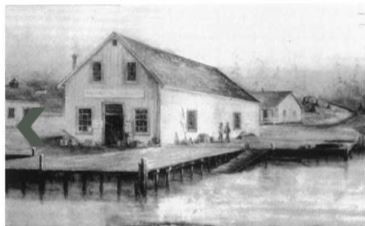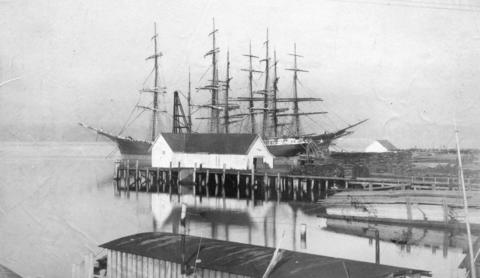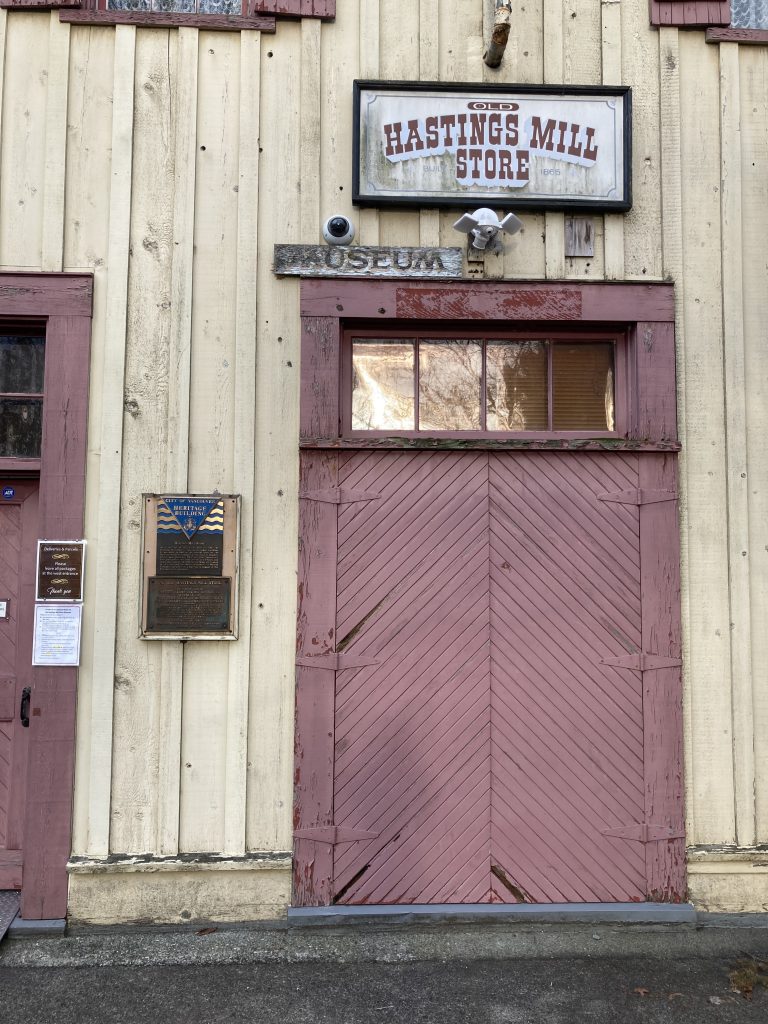A city built around resource extraction and the dispossession of indigenous lands and culture
The Hastings Mill Store was built in 1865 and is an important case study to examine how British colonists used land as an extractive resource to build industrial capital in BC. The colonial government systematically displaced and dispossessed the lands and culture of Indigenous people to create a profitable timber industry, which is reflected in the physical landscape and economic structures of what became the City of Vancouver to this day. The Hastings Mill Store sat at the center of this project, serving as a place for economic exchange between the working class and colonial elites. The mill’s townsite was organized to separate workers by race and class, with the Hastings Mill Store located near the residences of management, and administrators. The store also acted as a social gathering space, and by proximity, solidified the class hierarchy of the mill’s townsite layout.
Brief History
Before the Europeans arrived in 1860, the Burrard Inlet was inhabited by Coast Salish peoples, namely the Musqueum, the Squamish and the Tsleil-Waututh Nations. These nations fished, hunted and moved seasonally throughout a web of interconnected territories around Ay-Yul-Shun (English Bay), Sen̓áḵw (False Creek) and Səl̓ilw̓ət (Burrard Inlet).1 The Europeans arrived to these lands and saw this rich forested coastal region as a blank slate and profitable resource, despite it being home to Indigenous nations for generations.
In 1865, Captain Edward Stamp founded Stamps Mill with the capital of £100,000 and the colonial government’s permission to purchase 16,000 acres of timber along BC’s coast.2 In 1870, the mill was purchased from Stamp and became Hastings Mill, which was in operation until 1928. Hastings Mill was one of two mills, alongside Moodyville Sawmill, that produced and exported lumber in BC for markets all around the Pacific.3 The Hastings Mill Store was originally built in 1865 to operate as an economic and social hub for the townsite. It was the only store in the area, and for 20 years was one of the primary places for communication and economic exchange.
The Hastings Mill Store was the only building to survive the Great Vancouver Fire in 1886, and was used for hospitalization after this catastrophic event.4 A new store, and many other buildings were rebuilt after the fire. The old store building, having survived the fire, was used for storage in those later years. When Hastings Mill closed in 1928, the Native Daughters of British Columbia, who are a non-profit organization of women of European settler descent, towed the Hastings Mill Store building to a new site in Point Grey, Vancouver, where it has been preserved and operates as a museum to this day. The Native Daughters of BC were founded in 1919 with the objective of paying tribute to the pioneers of BC, in doing so, they claimed ownership to the history of BC and promoted the colonial empire.5
1 McDonald, Robert A. J. “Lumber Society on the Industrial Frontier: Burrard Inlet, 1863-1886.” Labour / Le Travail 33 (1994): 72
2 ibid. 73
3 ibid. 75
4 Cassidy Rose Ellis, “Preserving the ‘Glory of the Past’ : The Native Daughters of British Columbia and the Construction of Pioneer History in the Hastings Mill Museum” (Master of Arts, University of British Columbia, 2002): 28.
5 ibid. 24
Land as a Resource
The development of timber milling in BC, and Hastings Mill mark a significant point in the British colonial ‘origins’ of the City of Vancouver.6 The example of Hastings Mill highlights how extractive industries have engaged with existing Indigenous systems and changed their relationship to nature and culture.7 Derek John Woods reminds us in his thesis The Mill-Site: Victorian Processing in England and “Vancouver”, that the land had been occupied and was a rich cultural place for many Indigenous people long before the arrival of British settlers.8 He emphasizes that the arrival or European settlers and resource extraction was not the arrival of culture or economy to this area, “by the time mills were constructed on Burrard Inlet, the area had seen millennia of economic history.” 9 Woods goes on to say that the “survey and construction did not place the mill in a ‘wilderness,’ in ‘nature,’ or in any kind of asocial terra nullius. To the contrary, it meant reconfiguring many of the region’s ecologic and economic systems around the mill-site.” 10
6 Derek John Woods, “The Mill-Site: Victorian Processing in England and ‘Vancouver’; from Eliot to Marlatt” (Master of Arts, University of British Columbia, 2010): ii.
7 ibid. ii.
8 ibid. 49
9 ibid.49
10 ibid. 52
Monetary Control
The Hasting Mill Store demonstrates how colonists used monetary systems of control to shift the way Indigenous peoples relate to their land and modes of consumption. Monetary currency as defined by the colonial empire, was required to purchase anything at the store. As Indigenous labourers began to work on the mill, they became tied to this system of monetary exchange in order to meet their basic needs. This contrasted a way of life that had previously been about a reciprocal (non-exploitative) exchange with nature.11 In a review of the book Red skin, white masks by Glen Coulthard, the author Cliff Atleo points to ideas of Indigenous anti-colonialism which are “deeply informed by what the land as a system of reciprocal relations (…) can teach us about living our lives in relation to one another and the natural world in non-dominating and non-exploitative terms.” 12 The mill-site and store is one small example of the ways Indigenous people were forced into colonial forms of economic consumption.
Territorialization and Labour Control
Through self-proclaimed authority, the British crown re-territorialized Indigenous lands and transferred land rights to settlers who could afford the moderate sum. This was done with the goal of controlling settlement along this coastal region and promoting resource development on these lands. 13 This meant that Indigenous people were forced to live on reservations and work in the mills, while the colonial government further extracted from the surrounding territories and imposed restrictions on the lands and lives of Indigenous peoples. For many Indigenous groups, their natural cycle of seasonal migration was disrupted and replaced with labour employment and permanent living on one of the reservation areas around the mill-site. 14 Mariko Molander describes the importance of land control as a device for colonial development and states in her thesis, Decolonizing the Mind in Forestry
Canadian state-formation and colonial-capitalist development required first and foremost land, and the dispossession and primitive accumulation of Indigenous lands and resources were central to the expansion and establishment of the state and the development of liberal market rationalities and capitalist structures in western Canada.
(Molander, 24)
Modes of Communication
The process of land occupation and territorialization between white settlers and Indigenous nations did not come without struggle. Indigenous people were forced to adapt to the modes of communication set out by white settlers. Speaking and writing in English was one of the ways they adapted in order to inscribe their own stories in the narrative of Indigenous-settler relations.15 In 1864, 55 Coast Salish leaders wrote multiple petitions to protect their lands and push back against the many ways they were being marginalized within settler culture.16 One petition states:
For many years we have been complaining of the land left to us being too small. We have laid our complaints before the Government officials nearest to us: they sent us to some others; so we had no redress up to the present; and we have felt like men being trampled on, and are commencing to believe that the aim of the white men is to exterminate us as soon as they can, although we have always been quiet, obedient, kind, and friendly to the whites.
(Harvey, 53)
This example shows how Indigenous groups had to navigate the bureaucratic systems imposed on them by settler modes of communication, in an attempt to push back as colonists gained a stronghold over the material and environmental landscape of southwestern British Columbia.
11 Cliff Atleo, Jr., “Red Skin, White Masks: A Review,” Decolonization: Indigeneity, Education & Society Vol. 3, No. 2 (2014): 191
12 ibid. 191
13 Mariko Gwendolyn Molander, “Decolonizing the Mind in Forestry: Centring Settler-Colonial Dispossession and Mutually Contested Sovereignties in British Columbia’s Forestry Landscape and Narrative” (Master of Science, University of British Columbia, 2014): 25
14 McDonald, Robert A. J. “Lumber Society on the Industrial Frontier: Burrard Inlet, 1863-1886.” Labour / Le Travail 33 (1994): 72
15 Megan Harvey, “Story People: Stó:Lō-State Relations and Indigenous Literacies in British Columbia, 1864–1874,” Journal of the Canadian Historical Association Volume 24, no. 1 (2013): 53
16 ibid. 54
Segregated Spaces around the Mill’s townsite
- Mill foreman’s house.
- Rev. T.G. Thompson’s house.
- Surgery & Doctor’s office.
- Stevedore’s house.
- R.H. Alexander’s barn.
- R.H. Alexander’s house. mill manager’s house. The smaller wing at the rear of the building was the first mill manager’s house, Capt. J.A. Raymur.
- Fence.
- Hastings Mill Road connecting to Granville-Hastings Road.
- Hastings Mill school house.
- House.
- Mechanical engineer’s house.
- Caulfield Bros.
- Water tank.
- Calvert Simson’s house, shopkeeper.
- Main Office.
- The Old Old Mill Store; later used as a warehouse.
- Cook House and Dining Hall for employees.
People were segregated by race and class throughout the mill-site and surrounding area, ensuring that communication was limited between colonists and Indigenous people. The Indian Rancherie is an example of how segregation played out spatially, where Indigenous workers lived in their own settlement outside and away from mill townsite itself.17 Figure 1 shows the location of the Rancherie in relation to the mill-site and Figure 2 locates the Hastings Mill Store (#16) at the center of town in relation to the other buildings in the area. Robert A.J. McDonald, in his paper titled Lumber Society on the Industrial Frontier, describes the layout of the mill’s central townsite in relation to the Hastings Mill Store. The cottages of married men, bunkhouses for sink men, the mill manager’s residence and the Hastings Mill Store were all at the center of town, with the store being “the single most important merchant house on the shore.” 18
Figure 3 shows the image of the new store that was built after the fire of 1886, with store owner Calvert Simson and wealthy colonial administrators and businessmen standing out front. This image exemplifies the role of the central store in maintaining the class hierarchy within the mill-site’s physical boundaries, and how the store marked a central place for communication and exchange to happen amongst the influential elites. Derek Woods describes how, “the Hastings mill-site transform(ed) trees into lumber and capital, but it also serv(ed) as a communication relay point and function(ed) through symbolic additions of knowledge-power,” 19 reiterating the multiple ways in which the mill-site and store were used to assert power over land and people for the capital gain of the colony.
17 McDonald, Robert A. J. “Lumber Society on the Industrial Frontier: Burrard Inlet, 1863-1886.” Labour / Le Travail 33 (1994): 96
18 ibid. 79
19 Derek John Woods, “The Mill-Site: Victorian Processing in England and ‘Vancouver’; from Eliot to Marlatt” (Master of Arts, University of British Columbia, 2010): 66
The Building

The Hastings Mill Store was a two story building constructed of rough sawn cedar planks, set against a forested backdrop.20 Woods describes the area as a “a cluster of low wood buildings with shake roofs built partly on shore and partly on docks over the water.” 21 The image of the building in Figure 4. Shows how it was built to connect street and water, allowing goods to be moved from boats into the store fluidly. In an interview with one of Vancouver’s earliest settlers, recorded and published in 1945, John Scales describes the importance of the wharf in the functioning of the Hastings Mill Store, which “at any stage of the tide; (provided) a sloping place where boats could land their cargo.” 22 A larger image of how the wharf related to the boats and buildings, can be seen in Figure 5. from the Vancouver Archives. Mr. Scales also witnessed the construction of the first Hastings Mill Store and goes on to describe it being built.
We were coming along from Gastown in a canoe and I saw in front of me something I had never seen before. It was a great high thing and they were hauling a ‘stick’ (pile or pole) up it; we wondered what they were doing. It was a pile drive; I had never seen a pile driver before. Then, after a while, they had a big heavy piece of iron and they kept dropping it on top of the pile; they dropped it three times and that was the first pile ever driven, I should think, in Burrard Inlet.
(Matthews, 327)
From Scales’ description, the store was an open space that was filled with anything and everything needed on the mill-site. From tools for the mill to groceries, tobacco, tonics and spices. Mill-workers and loggers would come by boat to pick up their mail, gather goods from the store and exchange information.23 The building took on a utilitarian form that fit within the vernacular of the other industrial, and residential buildings that populated the mill-site. Using the local abundance of wood that was being produced at the mill, this building was created from a simple stick frame structural system that was easily assembled by the hands of labourers at the mill.

20 Derek John Woods, “The Mill-Site: Victorian Processing in England and ‘Vancouver’; from Eliot to Marlatt” (Master of Arts, University of British Columbia, 2010): 46
21 ibid. 46
22 Major James Skitt Matthews, Early Vancouver, Vol. 5 (Vancouver: City of Vancouver, 2011). 328
23 ibid. 328
Preservation of the Building
The gabled roof structure of the Hastings Mill Store building has withstood the test of time in materiality and form. This has not been without significant preservation efforts from the non-profit organization, The Native Daughters of BC. Still standing today at a relocated site on Point Grey Road in Vancouver, this building is now a museum to house and celebrate Vancouver’s colonial history and pioneer past. The building sits on unceded land of the Musqueam, Squamish and Tsleil-Waututh people, and celebrates a past that exploited, and dispossessed lands and culture from these Indigenous populations. The act of preservation of the Hastings Mill Building and the telling of this history has been done through the lens of the colonists, in service of promoting and celebrating the empire, and the myth of the frontier. Elizabeth Furniss, in her article titled Pioneers, Progress, and the Myth of the Frontier, states “the ubiquity of frontier histories reflects how certain colonial traditions of imagining history and constructing knowledge have come to dominate “common-sense” understandings of Canada’s past.”24
As a case study, and as a physical space, the Hastings Mill Store carries with it a colonial history that tells the story of how resource extraction and economy were used to displace and dispossess the lands of indigenous people for the profit of the colonial government and industry. The store operated at the center of this project and acted as a device for economic control, social control and segregation in the development of the colonial city of Vancouver. The preservation of this building as a historical landmark in the ‘origins’ of Vancouver, puts white settlers in a position of power by being the predominant voice in telling this story, and furthers the erasure of Indigenous culture.
24 Elizabeth Furniss, “Pioneers, Progress, and the Myth of the Frontier: The Landscape of Public History in Rural British Columbia,” BC Studies: The British Columbian Quarterly 115/116, no. Native Peoples and Colonialism (1998 1997): 8
Bibliography
Atleo, Jr.,Cliff. “Red Skin, White Masks: A Review,” Decolonization: Indigeneity, Education & Society Vol. 3, No. 2 (2014)
Ellis, Cassidy Rose. “Preserving the ‘Glory of the Past’ : The Native Daughters of British Columbia and the Construction of Pioneer History in the Hastings Mill Museum” (Master of Arts, University of British Columbia, 2002)
Furniss, Elizabeth. “Pioneers, Progress, and the Myth of the Frontier: The Landscape of Public History in Rural British Columbia,” BC Studies: The British Columbian Quarterly 115/116, no. Native Peoples and Colonialism (1998 1997)
Harvey, Megan. “Story People: Stó:Lō-State Relations and Indigenous Literacies in British Columbia, 1864–1874,” Journal of the Canadian Historical Association Volume 24, no. 1 (2013)
Matthews, Major James Skitt. Early Vancouver, Vol. 5 (Vancouver: City of Vancouver, 2011)
Macdonald, Bruce. “Vancouver: A Visual History.” Vancouver, BC: Talonbooks, 1992.
McDonald, Robert A. J. “Lumber Society on the Industrial Frontier: Burrard Inlet, 1863-1886.” Labour / Le Travail 33 (1994)
Molander, Mariko Gwendolyn. “Decolonizing the Mind in Forestry: Centring Settler-Colonial Dispossession and Mutually Contested Sovereignties in British Columbia’s Forestry Landscape and Narrative” (Master of Science, University of British Columbia, 2014)
Woods, Derek John. “The Mill-Site: Victorian Processing in England and ‘Vancouver’; from Eliot to Marlatt” (Master of Arts, University of British Columbia, 2010)
Images
Figure 1 – McDonald, Robert A. J. “Lumber Society on the Industrial Frontier: Burrard Inlet, 1863-1886.” Labour / Le Travail 33 (1994): 74
Figure 2 – Matthews, Maj. J.S. Early Vancouver Vol. 3 (Vancouver, City of Vancouver, 2011): 78
Figure 3 – Matthews, Maj. J.S. AM54-S4-: Mi P14. Hastings Mill Store. City of Vancouver Archives. 1888
Figure 4 – Macdonald, Bruce. “Vancouver: A Visual History.” Vancouver, BC: Talonbooks, 1992. 16
Figure 5 – Matthews, Maj. J.S. AM54-S4-: Mi P24. Hastings Mill Wharf. City of Vancouver Archives. 1887
Figure 6 – Kennedy, Charlotte. Hastings Mill Store at Alma and Point Grey Road. March 2021.

